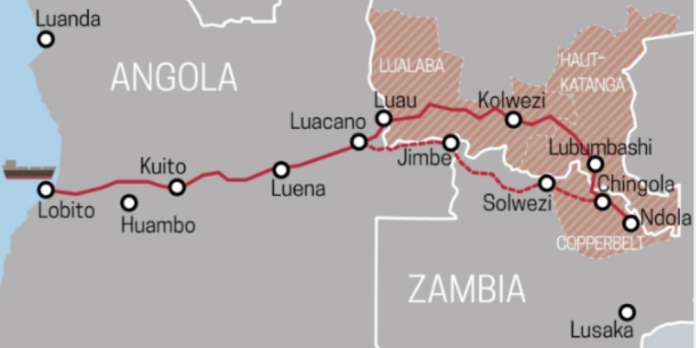US reluctant to finance Angola-Zambia extension of Lobito Corridor
The US International Development Finance Corporation has doubts about the relevance of extending the Lobito Corridor, which links Luacano in central-eastern Angola to Solwezi in northern Zambia, and may not finance the work.
Published on 04.03.2024 at 05:40 GMT Reading time 3 minutes
Scott Nathan, CEO of the US International Development Finance Corporation on 14 December 2022 in Washington. Scott Nathan, CEO of the US International Development Finance Corporation on 14 December 2022 in Washington. © Tasos Katopodis/Getty via AFP
The International Development Finance Corporation (DFC), a US state agency, announced in December it will finance work on the Angolan section of the Lobito Corridor, a multi-branch cross-border rail line that will transport Congolese and Zambian copper to the Atlantic coast.
The financing will be earmarked for the rehabilitation of the 1,300 km of railway linking the town of Lobito to the Democratic Republic of Congo (DRC) by the Lobito Atlantic Railway (LAR) consortium, which is made up of Portugal’s Mota-Engil, Switzerland’s Trafigura and Belgium’s Vecturis (AI, 15/12/23) and is chaired by Portugal’s Francisco Franca. Africa Intelligence understands the transaction should be finalised by June. But another part of the project may not see the light of day: the construction of a new railway line to create the Zambian section of the corridor and connect it to the existing Angolan one.
Production on the up
The DFC, which is headed by Scott Nathan, has been studying the commercial interest of the Angola-Zambia segment since last July, but is not convinced of its relevance. It would require the construction of an entirely new railway line in both countries, which would be much more expensive than rehabilitating the existing Angolan and Congolese lines.
This view is shared by the LAR consortium, which has been awarded a 30-year concession to rehabilitate and operate the Angolan railway as far as the DRC border. This is the case even though a Zambian extension would mean LAR extending its Angolan concession by ten years, in accordance with the agreement it has signed with Luanda.
The Congolese branch of the Lobito Corridor is once again operating between the Angolan border town of Luacano and Kolwezi in the DRC (AI, 22/01/24) and will later extend as far as Lubumbashi after the rehabilitation of the existing railway. Alongside this is the Zambian section of the railway, a brand-new line, which seems much less crucial to the US.
The DRC produced around 2.3m tonnes of copper in 2023 – compared with Zambia’s around 800,000 tonnes – thanks in particular to sites where production is rising sharply.
These include the Kamoa-Kakula complex, near Kolwezi, operated by the Canadian company Ivanhoe Mines headed by Robert Friedland, which is already producing 400,000 tonnes a year. Ivanhoe is the first mining company to transport its copper from Kolwezi to Lobito thanks to an agreement with the LAR consortium.
Zambia’s current leading copper producer, Canada’s First Quantum, which is based at the Kanshanshi mine near Solwezi, produced just 135,000 tonnes last year, although it is aiming for 250,000 tonnes a year. Vedanta, a mining conglomerate owned by Indian-British binational Anil Agarwal which has just finalised its return to Konkola Copper Mines (AI, 31/01/24), operates at a copper site located in Chingola in northeast Zambia, a long way from the Angolan border.
Vague about where money will go
But the DFC does not want its decision not to fund the Zambian branch at Lobito to be seen as a U-turn by its Zambian and European partners. The $1.6bn memorandum of understanding, announced with great fanfare on 26 October in Brussels at the Global Gateway Forum, was vague about the distribution of the money, and concerned all the branches of the Lobito Corridor.
It was presented as joint financial support coordinated by Amos Hochstein, President Joe Biden’s energy adviser, European Commissioner for International Partnerships Jutta Urpilainen, and the African Development Bank (AfDB).
These donors signed a memorandum of understanding with DRC Prime Minister Jean-Michel Sama Lukonde Kyenge, Angolan Coordination Minister José de Lima Massano and Zambian Finance Minister Situmbeko Musokotwane. The United States and the European Union used the occasion to encourage Lusaka to launch feasibility studies on this new segment.


If the three governments are serious about this project they should look east. China is an all weather friend. Forget about the west.
If there is nothing in it for us, then we are out of it. After they do the railway, we will do one for ourselves linking into the line, not through DRC, but through Kaleni into Angola.